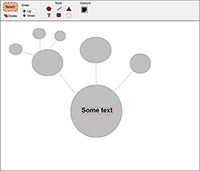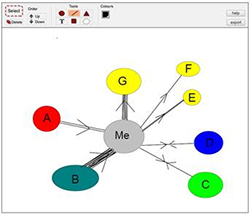7 Networks of interaction
The following activity will help you reveal your own network of interaction that spreads throughout your organisation.
Activity 3: Your network of interaction
Part A
In this activity, you are asked to investigate your existing network of interaction – to think about the colleagues and departments with whom you communicate or exchange with in a typical week or month.
What is the strength of these connections? There are several (all imperfect) approaches to investigating connection strength listed below; which one you choose depends on the nature of your work and the ways you deal with others.
- Roughly how many bytes of data pass in email threads or other media transferred between you and other parties? Get a sense of this by looking at your inbox and sorting it by size of message – or by looking at the documents or data you’ve worked with this week or month.
- With whom do you exchange the most emails? Sort your outbox by ‘To’ and check over emails sent in the last week or month (you may wish to clear out your box for previous months first).
- How much time are you spending with different people in a given week or month? Do you have an appointment book, schedule, timesheet or time-tracking app that would indicate this?
- Which projects, tasks or workstreams take up most of your time? There may be clear ‘outputs’ you produce which allow you to (honestly and without prejudice) judge this for yourself. Again you could track messages or parts of the work which are collaborative – or you could even keep a diary for a week to find out.
- If you’re used to tracking your performance in terms of income generated from a range of clients, you may be in a position to judge strength of interaction in terms of money received over a given period.
Other more appropriate ways may occur to you. Select one method.
Whichever way you choose to do this activity, by applying the method consistently to all the different people/bodies you deal with, you should be able to build up a picture of your own network of interactions.
Write down the names of 10–15 main stakeholders, in order of the strength of your connection.
Part B
To complete the next part of this activity we invite you to use the interactive whiteboard tool, provided below. The tool will save whatever you draw here on this site, so you can return to it during your study. If you would rather perform this activity on a large piece of paper please do so, but keep it safe to refer to in future activities.
Write ‘me!’ at the centre of the page/screen, and around the outside write down the 10–15 main stakeholders featured in your analysis of who you’re interacting with and how strongly. Draw connecting lines between yourself and each stakeholder. Thick lines where the relationships are strong (by whatever means you judge strength) and thinner lines where the relationships are weaker.
If you’ve time, you might want to embellish your picture with some additional features:
- clustering or labelling stakeholders in terms of the nature of the relationship
- drawing arrows to represent the general flow of goods/services/information in to and out from yourself
- considering which stakeholders have most influence over you and labelling these
- naming more stakeholders whom you know are connected to the ones you’re connected to, but who don’t generally interact with you – they may form another layer of interaction sitting behind your own.
Click ‘View’ to access the interactive whiteboard tool. There are a number of shape tools available to choose from, as well as the ability to enter text. Once you have created an element of the map you can use the 'Select' option to drag and drop it, the Order ‘Up’ and ‘Down’ buttons to move it to the foreground or background, or the ‘Delete’ option to get rid of it entirely. After you have mapped the stakeholders you can save your final map here and also export a copy to print off.
Feedback
In light of the diagram you have produced, now ask yourself the following:
- Which parts of my organisation are not mapped out on this sketch? Do those unseen parts sit behind stakeholders I have included – or do they have no representation in my diagram at all?
- Why is it that I’m not better connected beyond the people/bodies included here? There may be good reasons for not being directly connected, but what am I ‘not seeing’ because I only have these channels of interaction?
So far, you should have had an opportunity to identify your ‘blind spots’ within the organisation to which you belong. In the next section you will develop a more formalised and complete picture of your organisational situation.


